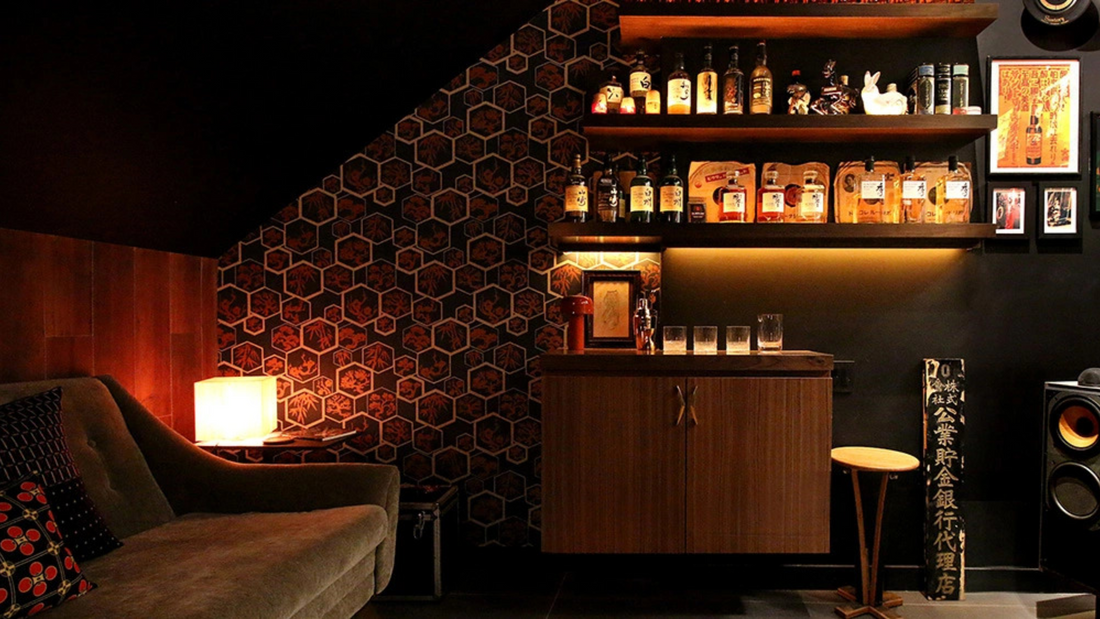
How to Begin a Whisky Shelf Collection at Home
By Rafi Mercer
There comes a moment when the bottles on your kitchen counter begin to feel less like afterthoughts and more like companions. A bottle of whisky is not just something to pour at the end of a day; it is a piece of place, a fragment of time, a voice waiting to be heard.
To begin a whisky shelf at home is to begin a kind of library — one written in oak and malt instead of paper and ink, one you return to depending on mood, company, or the record spinning on the turntable.
For those of us drawn to the culture of listening bars, the whisky shelf is a natural extension. Just as you build a collection of albums that shape rooms, so too you build a collection of whiskies that shape evenings. Each bottle carries its own geometry: peat that fills space, sherry that deepens shadows, honey that brightens corners. To start a shelf is to curate an atmosphere.
The temptation when you start is to buy the most celebrated bottles — the Macallans, the Yamazakis, the names that whisper prestige. But a whisky shelf is not about prestige; it is about range. Think of it as building a record collection. You need the classics, of course, but you also need variety: jazz beside dub, ambient beside funk. On your whisky shelf, that means smoke beside sweetness, light alongside depth, a dram for every kind of night.
A good way to begin is with a handful of bottles that mark the compass points of whisky flavour. From Scotland, Lagavulin 16 for Islay smoke, GlenDronach 15 for sherry richness, Glenmorangie Signet for modern chocolate depth, and Oban 14 for maritime balance. Add one or two lighter styles — a Lowland such as Glenkinchie, or a Japanese malt like Hibiki — and your shelf already speaks many dialects.
Whisky is more than liquid. Each distillery carries history: towns built around stillhouses, landscapes folded into flavour. To collect bottles is to collect stories. When you pour Springbank 10, you taste Campbeltown’s industrial past and stubborn independence. When you uncork Bunnahabhain 12, you encounter Islay without peat, a softer voice from a famously smoky island. These are not just drinks; they are places you can return to.
And that is the secret to building a shelf — choose bottles that resonate with you. If you visited Oban and named your dog after it, then that bottle becomes more than a flavour profile. If a dram of Caol Ila once accompanied Brian Eno in a listening bar, then that bottle holds memory as much as taste. A shelf should look back at you like a diary.
In listening culture, albums are chosen not just for genre but for mood — morning clarity, midnight intensity, Sunday calm. A whisky shelf works the same way. There are drams for conversation (Balvenie DoubleWood 12, honeyed and soft), drams for solitude (Caol Ila 12, clean smoke and lemon), and drams for celebration (Macallan 18, polished grandeur).
As the shelf grows, you begin to see it less as a display and more as a palette. Friends come over, the record is chosen, and you stand in front of your bottles like a DJ at the decks. Tonight calls for richness? Glenfarclas 25. Something bright and coastal? Old Pulteney 12. Something experimental? A world whisky from India or Taiwan. The bottles, like records, shape the room.
There is no rush. Part of the pleasure is in the gradual accumulation, the way one bottle leads to another, the way curiosity builds. Start with four or five, drink them, learn them. Notice how one bottle disappears faster than the others — a sign that it suits your evenings best. Notice which one lingers, waiting for the right moment. Your shelf teaches you as much as you teach it.
Over time, you may find yourself reaching for the unusual: a single cask, a cask strength, a bottling from an independent label. These become the rare vinyl pressings of the whisky world — not necessary, but cherished. They give your shelf texture, surprise, and personality.
The real reason to build a whisky shelf is not the display. It is the architecture it creates in your life. A row of bottles is a row of possibilities. Each dram is a different room you can step into: smoky halls, sherried cathedrals, bright gardens, coastal walks. To collect whisky is to collect spaces.
And just as with listening bars, the point is not ownership but experience. The shelf is not a museum. The bottles are meant to be opened, shared, poured. They are there to soundtrack evenings, to sharpen memory, to turn conversation into ritual.
In the end, a whisky shelf is a quiet invitation. It says: stay a while, sit down, let the evening unfold. Just as a record collection reveals its owner’s taste and history, a whisky shelf reveals the rooms they like to inhabit. Some shelves lean towards Islay, some towards Speyside, some towards the experimental edge of world whiskies. None are wrong; all are personal.
What matters is that the shelf grows honestly, bottle by bottle, story by story. Begin with balance, add bottles with meaning, drink by atmosphere, and let curiosity guide the rest.
Because the truth is this: a whisky shelf is not really about the whisky. It is about memory, sound, and place. It is about slowing down in a world that wants to hurry you along. It is about creating, in your own home, the same resonance you feel in a listening bar: the music playing, the glass in hand, the room unfolding in detail.
Rafi Mercer writes about the spaces where music matters. For more stories from Tracks & Tales, subscribe, or click here to read more.














